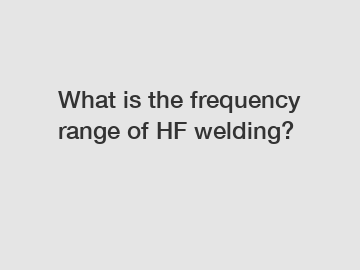What is the frequency range of HF welding?
What is the frequency range of HF welding?
HF welding, also known as high-frequency welding, is a widely used technique in various industries for joining thermoplastic materials. It utilizes an electromagnetic field to generate heat in the workpieces, causing them to melt and fuse together. The frequency range of HF welding is a crucial aspect of the process, as it determines the efficiency and effectiveness of the welding operation. In this article, we will explore the frequency range of HF welding and its impact on the welding process.
1. Defining the frequency range:

The frequency range of HF welding refers to the range of radio frequencies used in the welding operation. HF welding typically operates in the frequency range of 12 to 25 megahertz (MHz). This range allows for efficient energy transfer to the workpieces, creating enough heat to melt the thermoplastic materials without causing any damage.
2. Importance of frequency selection:
The selection of the appropriate frequency for HF welding depends on several factors, including the type and thickness of the materials being welded, the desired welding speed, and the level of precision required. Different materials have varying dielectric properties, which determine how they respond to high-frequency energy. Additionally, the thickness of the materials affects the penetration depth of the electromagnetic field. Thus, it is crucial to choose the optimal frequency range for each welding application.
3. Effects of frequency on weld quality:
The frequency range of HF welding significantly affects the quality of the weld joint. At lower frequencies, such as 12 MHz, the electromagnetic field penetrates deeper into the workpieces, resulting in better heat distribution. This deep penetration is particularly advantageous when welding thicker materials, ensuring a strong and uniform bond. On the other hand, higher frequencies like 25 MHz provide better control over the welding process, allowing for precise and localized heating. This makes them more suitable for thin and delicate materials.
4. Considerations for material selection:
Different materials exhibit distinct behavior under high-frequency energy, necessitating careful consideration during the material selection process. For example, polyvinyl chloride (PVC) is commonly welded at frequencies around 13 MHz, as it responds well to this range. However, other materials like polyurethane or polyester may require higher frequencies for successful welding. Understanding the dielectric properties of the materials is crucial in determining the appropriate frequency range for each application.
5. Impact on production efficiency:
The frequency range of HF welding has a direct impact on production efficiency. By selecting the optimal frequency, manufacturers can achieve faster and more reliable welding processes. As mentioned earlier, higher frequencies offer better control and precision, which can lead to faster cycle times. On the other hand, lower frequencies are more suitable for thicker materials, ensuring a robust and durable weld.
6. Considerations for specialized applications:
In certain specialized applications, such as medical device manufacturing or automotive industries, specific frequency ranges may be required. These industries often deal with unique materials or have stringent quality requirements that necessitate precise control over the welding process. In such cases, customized frequency ranges are chosen to ensure the highest standards of quality and performance.
In conclusion, the frequency range of HF welding plays a crucial role in determining the efficiency and quality of the welding process. Selecting the appropriate frequency range based on material properties, thickness, and application requirements is essential. Whether aiming for deep penetration in thicker materials or precision in delicate assemblies, understanding the impact of frequency selection is key to achieving successful and reliable welds. With the right frequency range, manufacturers can optimize their production efficiency, resulting in high-quality finished products across various industries.
Want more information on CNC induction hardening equipment, high frequency solid state induction welder, solid state welder repairs? Feel free to contact us.


